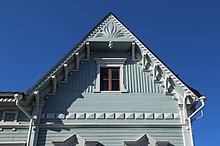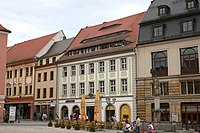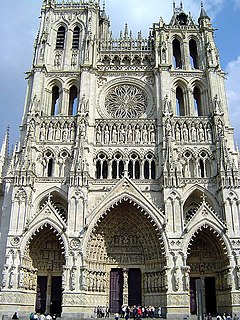


A gable is the generally triangular portion of a wall between the edges of intersecting roof pitches. The shape of the gable and how it is detailed depends on the structural system used, which reflects climate, material availability, and aesthetic concerns. The term gable wall or gable end more commonly refers to the entire wall, including the gable and the wall below it. Some types of roof do not have a gable (for example hip roofs do not). One common type of roof with gables, the 'gable roof', is named after its prominent gables.
A parapet made of a series of curves (shaped gable, see also Dutch gable) or horizontal steps (crow-stepped gable) may hide the diagonal lines of the roof.
Gable ends of more recent buildings are often treated in the same way as the Classic pediment form. But unlike Classical structures, which operate through trabeation, the gable ends of many buildings are actually bearing-wall structures.
Gable style is also used in the design of fabric structures, with varying degree sloped roofs, dependent on how much snowfall is expected.
Sharp gable roofs are a characteristic of the Gothic and classical Greek styles of architecture.
The opposite or inverted form of a gable roof is a V-roof or butterfly roof.
Front-gabled and side-gabled
While a front-gabled or gable-fronted building faces the street with its gable, a side-gabled building faces it with its cullis (gutter), meaning the ridge is parallel to the street. The terms are used in architecture and city planning to determine a building in its urban situation.
Front-gabled buildings are considered typical for German city streets in the Gothic period, while later Renaissance buildings, influenced by Italian architecture, are often side-gabled. In America, front-gabled houses, such as the gablefront house, were popular between the early 19th century and 1920.
-
Front-gabled buildings in Tübingen in Baden-Württemberg in Germany
-
 Side-gabled buildings in Bautzen in Saxony, Germany
Side-gabled buildings in Bautzen in Saxony, Germany
Wimperg
Main article: Wimperg
A Wimperg, in German and Dutch, is a Gothic ornamental gable with tracery over windows or portals, which were often accompanied by pinnacles. It was a typical element in Gothic architecture, especially in cathedral architecture. Wimpergs often had crockets or other decorative elements in the Gothic style. The intention behind the wimperg was the perception of increased height.
Drawbacks
| This section possibly contains original research. Please improve it by verifying the claims made and adding inline citations. Statements consisting only of original research should be removed. (August 2015) (Learn how and when to remove this message) |
The gable end roof is a poor design for hurricane or tornado-prone regions. Winds blowing against the gable end can exert tremendous pressure, both on the gable and on the roof edges where they overhang it, causing the roof to peel off and the gable to cave in.
In popular culture
- "The Seven Lamps of Architecture", an 1849 essay. It gives John Ruskin's opinion on truth in architecture
- The House of the Seven Gables, an 1851 novel by Nathaniel Hawthorne
- Anne of Green Gables, a 1908 novel by Canadian author Lucy Maud Montgomery, set in Canada
- "The Adventure of the Three Gables", a 1926 story by Arthur Conan Doyle.
See also
- Bell-gable (espadaña)
- Clock gable
- Cape Dutch architecture
- Eaves
- Façade
- Gablet roof
- Hip roof
- List of roof shapes
- Tympanum (architecture)
References
- Clarke 2010, p. 106.
- Passmore, Augustine C. "Twenty Styles of Architecture". Handbook of Technical Terms Used in Architecture and Building and Their Allied Trades and Subjects. London: Scott, Greenwood, and Co., 1904. 360. Print.
- "Gâble (wimperg)". A Glossary of Romanesque Architecture. 24 January 2013. Retrieved 12 October 2015.
- "Roof damage by hurricane force winds in Bermuda". (Archived 2013-05-20 at the Wayback Machine), Mark Rowe, Department of Environmental Protection, Government of Bermuda. The Fabian Experience, September 2003, page 5.
- Grazulis, Thomas P. (1993). Significant tornadoes, 1680–1991. St. Johnsbury, Vt.: Environmental Films. p. 106. ISBN 1-879362-03-1.
Further reading
- Clarke, M. (2010). "gable". The Concise Oxford Dictionary of Art Terms. Oxford Paperback Reference. OUP Oxford. p. 106. ISBN 978-0-19-956992-2. Retrieved 2024-12-24.
- Pugin, Augustus (1915) . A Series of Ornamental Timber Gables, from Existing Examples in England and France of the 16th Century. Cleveland, Ohio: J. H. Jansen, Publisher. OCLC 3055073.
External links
- Chisholm, Hugh, ed. (1911). "Gable" . Encyclopædia Britannica. Vol. 11 (11th ed.). Cambridge University Press. p. 380.
- Lexicon of architecture (in German), retrieved August 13, 2022
| Rooms and spaces of a house | |
|---|---|
| Shared rooms | |
| Private rooms | |
| Spaces | |
| Technical, utility and storage |
|
| Great house areas | |
| Other | |
| Architectural elements | |
| Related | |
